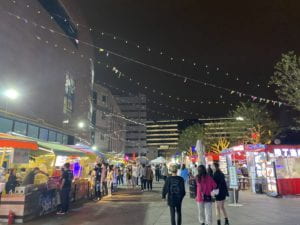In our mapping project, we investigated the operation of mobile food stands under the control of Shanghai Government after the epidemic of COVID-19. It has been long time in first-tier cities in China that mobile food stands were unwelcome in the eye of government. As a form of informal economy, the emergence of mobile food stands are related to issues of immigrant labors, unemployment, city planning, garbage disposal. Although never regarded as an organic part of urban life and strictly prohibited for a long time, mobile food stands never disappear. Scattered food vendors wander through the city during rush hour, staying for several hours and then leave.
Only when the COVID-19 economically hit the city to a great extent did the government realize the function of mobile food stands, which was ignored intentionally in the past.They thought they should do something to show their encouragement to ease the environment for informal economy, as a result, they started their plan, incorporating mobile food stands into part of infrastructure, a kind of public resources that every citizen is able to share. That is a common logic for government to take control over economic activities: to classify, to divide, to specify and incorporate. To make a city more ordered, clean and tidy, mobile food stands were carefully designed and gathered together and fixed, appearing as a special landscape in the post-epidemic period. An independent mobile food stand, which is able to self-supported as a small system, is deconstructed into small parts to assimilate into the city: space, facilities, electricity, operation system that includes food resource and marketing, garbage disposal, and assigned to corresponding part of a formal economy, a nearby shopping mall or a supermarket or something else.
The reason I believe that mobile food stands are being made part of infrastructure is that, it is being designed as neither pure economic activity nor complete cultural landscape, but a combination of both. Thus it becomes a steady, fixed, clustered organization, a network is built within it with man-made systems and processes that function collaboratively and synergistically. Connecting mobile food stands with their surroundings only technically ensures better control while getting rid of their distinct features.

In addition, I think mobile food stand is turned into infrastructure is in a more conceptual way. Through planning and regulation, the mobile food system is able to maintain for a relatively long period compared to what was in the past due to government fund. Under the context of designing, the image of clustered mobile food stands is fixed, at least it is managed to sustain as a landscape for current purpose without considering real consumption because government is supporting it. People do not really consume it, while it still stands. The change of mobile food stands from pure economic activity to a concept of infrastructure take place when people is just watching it, or we can say, enjoy it visually in most circumstance without inner motivation.
Leave a Reply